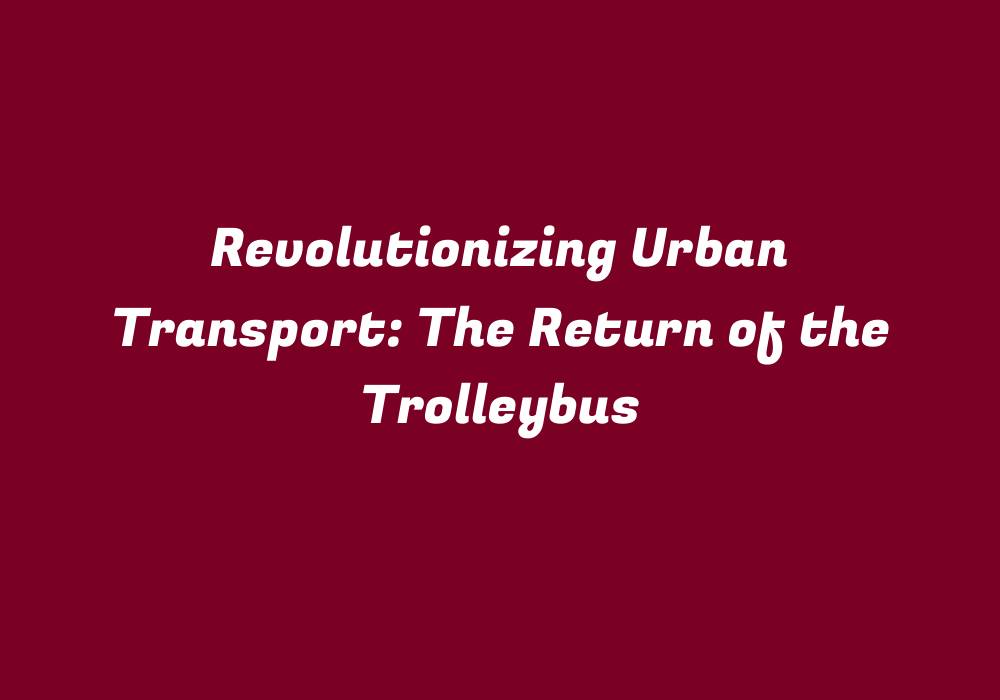Revolutionizing Urban Transport: The Return of the Trolleybus
The transportation landscape is undergoing a significant change as cities worldwide are exploring new and innovative ways to improve their urban transport systems. One unique solution gaining popularity is the revival of trolleybuses, which promise to bring sustainability, efficiency, and accessibility to public transit. This article will delve into the history of trolleybuses, their advantages over conventional buses, and how they are being embraced in urban transport systems around the globe.
A Brief History
The trolleybus made its first appearance in 1879 in the United States when inventor Frank J. Sprague introduced a vehicle that combined the features of both streetcars and buses. The initial concept aimed to create an environmentally friendly alternative to traditional vehicles, powered by electricity from overhead wires instead of fossil fuels.
The trolleybuses became popular during the early 20th century, particularly in Europe and the United States, where many cities used them as part of their mass transit networks until the 1960s and ’70s. However, they were gradually replaced by diesel buses due to their perceived lower costs and operational flexibility.
Trolleybuses: A Renewed Interest
In recent years, cities have experienced a surge in urbanization and population growth, which has led to an increased demand for public transportation systems capable of catering to the needs of more people. Consequently, governments and transit authorities worldwide are reassessing their approach to urban mobility.
The trolleybus has emerged as a promising solution due to its numerous advantages over conventional buses:
1. Environmentally friendly: Trolleybuses emit zero tailpipe emissions during operation, reducing air pollution in cities. They also eliminate the need for harmful diesel exhaust fumes and minimize noise pollution, thus promoting cleaner urban environments.
2. Lower operational costs: Despite initial investment in overhead wires and charging infrastructure, trolleybuses often offer significant long-term savings due to their lower maintenance expenses compared to diesel buses. Electric motors have fewer moving parts and are more durable, resulting in reduced repair and replacement costs over time.
3. Improved energy efficiency: Electric motors used in trolleybuses typically boast a higher energy conversion efficiency than internal combustion engines, leading to lower energy consumption per passenger-kilometer traveled. This contributes to a reduction in overall operating expenses for the transit authority.
4. Passenger comfort: Trolleybuses offer smooth and quiet rides compared to diesel buses, which can be noisy and uncomfortable due to their engine’s vibrations. This often leads to improved passenger satisfaction ratings and better ridership levels.
5. Increased accessibility: Electric motors in trolleybuses provide more consistent power delivery, enabling easier ascending of steep hills and acceleration compared to diesel buses, which struggle in such environments. Additionally, the need for regular engine maintenance is reduced, improving reliability and availability of services.
Revival of Trolleybus Systems Around the Globe
Cities worldwide are now embracing the trolleybus concept to improve their urban transport systems. Some notable examples include:
1. Vienna, Austria: With over 300 trolleybuses in operation and a total length of more than 540 kilometers of tracks, Vienna has one of the largest and most successful trolleybus networks globally.
2. Budapest, Hungary: The city’s modernized trolleybus system is designed to improve air quality by reducing emissions in the urban center, while also providing an efficient alternative for commuters.
3. Bogotá, Colombia: As part of its efforts to reduce congestion and promote sustainable transportation, Bogotá introduced a new trolleybus line connecting the city’s main business district with the northern neighborhoods in 2019.
4. Istanbul, Turkey: The country’s largest metropolis is currently planning to invest $3 billion into expanding its electric bus fleet and infrastructure, which includes the introduction of trolleybuses to improve urban transport efficiency and reduce air pollution.
5. Moscow, Russia: The city is committed to promoting cleaner transportation by integrating a modernized trolleybus system with its existing metro network, aiming to provide seamless connectivity for passengers.
6. Toulouse, France: The French city’s innovative public transport system includes an electric bus network featuring 13 trolleybus lines and plans to extend this infrastructure in the coming years.
Conclusion
The reemergence of trolleybuses as a key element in urban transportation systems demonstrates that innovation and sustainability are integral aspects of modern-day mobility. As cities continue their quest for cleaner, more efficient modes of mass transit, the trolleybus is poised to become an increasingly popular choice for improving the overall quality of life for urban dwellers worldwide. By combining the benefits of both streetcars and buses, this age-old transportation solution offers a promising glimpse into the future of urban transport systems, making cities more sustainable and enjoyable places for all.
